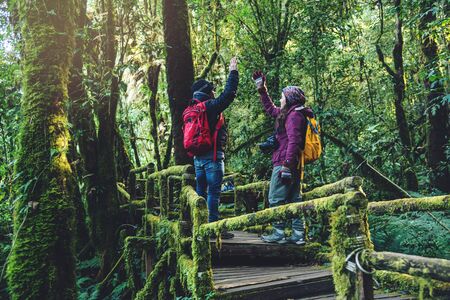1. Choosing the Right Trail for Your Group
Picking the perfect trail is the first step to making sure your family or group hike is safe, fun, and memorable. The United States has a huge variety of hiking trails, from the breathtaking paths in National Parks to hidden gems in local nature preserves. Here’s how you can choose a trail that fits everyone’s needs and abilities.
Consider Age and Fitness Levels
It’s important to match the trail with the youngest, oldest, or least experienced hiker in your group. Trails are usually rated as Easy, Moderate, or Difficult. Beginners and families with young kids should start with Easy trails—these are often shorter, flatter, and well-marked. If your group includes teenagers or adults who hike regularly, you might try Moderate trails, which can have some hills or longer distances. Save Difficult trails for experienced hikers who want a real challenge.
Trail Difficulty Levels at a Glance
| Difficulty Level | Description | Recommended For |
|---|---|---|
| Easy | Flat or gently rolling terrain; short distance (usually under 3 miles); clearly marked paths | Families with children, beginners, seniors |
| Moderate | Some elevation gain; uneven surfaces; longer distances (3-6 miles) | Active adults, teens, groups with some hiking experience |
| Difficult | Steep climbs; rocky or rough terrain; long distances (over 6 miles) | Experienced hikers, fit adults seeking adventure |
Look for Popular US Trail Systems
The US is home to some amazing trail networks. National Parks like Yosemite, Yellowstone, and Great Smoky Mountains offer well-maintained trails suitable for all levels. Many state parks and local preserves also have great options. Check each location’s website for maps and details about trail length, difficulty, and features.
Popular Family-Friendly Trails in National Parks:
- Yosemite National Park: Lower Yosemite Fall Trail – 1 mile loop, easy walk with waterfall views.
- Zion National Park: Riverside Walk – 2 miles round trip along the Virgin River.
- Great Smoky Mountains: Laurel Falls Trail – 2.6 miles round trip to a scenic waterfall.
- Acadia National Park: Jordan Pond Path – 3.5 mile flat loop around a picturesque pond.
Check Local Weather and Trail Conditions
No matter where you plan to go, always check the current weather forecast and trail conditions before heading out. Some trails may be closed after storms or during certain seasons. Local park ranger stations or visitor centers can provide up-to-date information.
Accessibility Matters
If anyone in your group has mobility challenges or uses a stroller or wheelchair, look for ADA-accessible trails. Many parks now offer paved or hard-packed paths designed for everyone to enjoy safely.
2. Safety and Preparation Essentials
Leave No Trace: Protecting Nature Together
When hiking in the US, it’s important to follow the Leave No Trace principles. This means you should always pack out what you bring in, stay on marked trails, respect wildlife, and leave natural things as you found them. Teaching kids and group members about these basics keeps parks clean and beautiful for everyone.
Quick Guide to Leave No Trace Principles
| Principle | Simple Example |
|---|---|
| Plan Ahead & Prepare | Check park rules; bring enough water and snacks |
| Travel & Camp on Durable Surfaces | Stick to established trails and campsites |
| Dispose of Waste Properly | Packing out trash, using restrooms if available |
| Leave What You Find | Don’t pick flowers or take rocks as souvenirs |
| Respect Wildlife | Observe animals from a distance; never feed them |
| Minimize Campfire Impact | Use camp stoves or existing fire rings when allowed |
| Be Considerate of Others | Yield to others on the trail; keep noise down |
Understanding Trail Signage and Markers
US trails use signs and colored blazes to guide hikers. Always read trailhead signs—they’ll tell you about trail difficulty, length, possible hazards, and any special rules. Teach your group to recognize common symbols, like arrows for direction or different colors for specific trails. If in doubt, ask a ranger before starting your hike.
Common US Trail Marker Colors:
- Blue: Often used for side trails or loop connectors.
- White: Main trail (like the Appalachian Trail).
- Red/Orange: Typically marks more challenging routes.
- Yellow: Shorter or easier paths.
Weather Awareness: Stay Safe Year-Round
The weather can change quickly in US national parks and forests. Always check the forecast before your hike. In summer, watch out for thunderstorms—seek shelter if you hear thunder. In winter or mountain areas, be prepared for sudden cold snaps or snow. Dress in layers and bring rain gear just in case.
Packing a Family-Friendly First Aid Kit
A well-stocked first aid kit is essential for every hike. Here’s a simple list of what to include for families or groups:
| Item | Packed? |
|---|---|
| Bandaids (various sizes) | ☐ |
| Moleskin (for blisters) | ☐ |
| Tweezers (for splinters/ticks) | ☐ |
| Sunscreen & insect repellent | ☐ |
| Pain relievers (Tylenol/Advil) | ☐ |
| Ace bandage (for sprains) | ☐ |
| Cleansing wipes & hand sanitizer | ☐ |
| An emergency blanket or poncho | ☐ |
Communicating Plans with Park Rangers or Authorities
If you’re visiting a national or state park, stop by the visitor center or ranger station before hitting the trail. Let someone know which route you plan to take and when you expect to return. This is especially important in remote areas where cell service may be limited. Some parks have sign-in boards at trailheads—use them so rangers know who’s out there. If hiking with kids or a large group, consider carrying a whistle and teaching everyone how to use it in case someone gets separated.
Your Safety Checklist Before Hiking:
- Told someone about your hiking plans?
- Brought enough water and snacks?
- Packed a map and checked your route?
- Dressed appropriately for the weather?
- Brought your first aid kit?
- Taught everyone basic safety rules?
With these essentials covered, your family or group will be ready for a safe adventure on America’s incredible trails!
![]()
3. Packing Smart: Gear and Food Tips
Essential Hiking Gear for Families and Groups
When heading out on a family or group hike in the US, packing the right gear can make all the difference. Here are some key items to consider:
| Gear Item | Why Its Important |
|---|---|
| Hydration Packs/Water Bottles | Staying hydrated is crucial, especially on long trails or in hot weather. Hydration packs allow hands-free sipping, making them great for kids and adults alike. |
| Proper Footwear | Sturdy hiking boots or trail shoes protect your feet and provide support on uneven terrain. Make sure everyone tries on their footwear before the hike to avoid blisters. |
| Weather-Appropriate Clothing | Dress in layers so you can adjust to changing conditions. Lightweight, moisture-wicking fabrics work best. Don’t forget hats, sunglasses, and rain jackets! |
| Daypack/Backpack | A comfortable backpack makes it easy to carry extra clothes, snacks, and first aid supplies. |
| First Aid Kit & Safety Gear | Packing bandages, antiseptic wipes, insect repellent, sunscreen, and a whistle keeps everyone prepared for minor mishaps. |
Family-Friendly Snack Ideas for the Trail
Packing nutritious snacks helps keep energy levels up during your hike. Choose foods that are easy to eat on-the-go and won’t spoil quickly.
| Snack Idea | Description |
|---|---|
| Trail Mix | A classic American favorite—combine nuts, dried fruit, and chocolate chips for a sweet-and-salty treat. |
| Granola Bars/Energy Bars | Portable and packed with energy; look for options with whole grains and minimal added sugar. |
| Sliced Apples & Peanut Butter Packets | A kid-friendly combo that’s both tasty and filling. |
| String Cheese or Cheese Cubes | A good source of protein that doesn’t require refrigeration for a few hours. |
| Beef Jerky or Turkey Jerky | A traditional American snack that provides protein without needing special storage. |
| Squeeze Pouches (Applesauce/Yogurt) | No mess and perfect for younger hikers. |
Packing Meals: Outdoor Regulations & Customs in the US
Follow Leave No Trace Principles
The United States has strong outdoor ethics—especially the “Leave No Trace” principles. This means you should pack out everything you bring in, including food wrappers and leftovers. Bring reusable containers or zip-top bags to reduce waste.
Tips for Packing Meals:
- Avoid glass containers—they’re heavy and can break easily.
- If you plan to cook or picnic at a designated area, check local regulations about open flames or portable stoves—fire restrictions are common in many US parks during dry seasons.
- If you’re hiking in bear country (such as national parks in the Rockies or Sierra Nevada), use bear-proof canisters for storing food and scented items like toothpaste or sunscreen.
- Always bring extra snacks in case your hike takes longer than planned—a hungry group is never fun!
Quick Checklist Before You Go:
- Double-check everyone has water and weather-appropriate clothes.
- Packing lightweight snacks that don’t need refrigeration.
- Bring enough garbage bags to pack out all trash.
With smart packing and a little planning ahead, your family or group hike will be safe, comfortable, and full of happy memories!
4. Engaging Kids and Group Members
Keeping Everyone Excited on the Trail
One of the best ways to ensure a fun and memorable group or family hike in the US is by keeping both kids and adults engaged throughout the journey. Here are some creative ideas that can help everyone stay involved and enthusiastic.
Fun Trail Games for All Ages
| Game Name | Description | Best For |
|---|---|---|
| I Spy | Take turns spotting objects or animals along the trail using clues. Helps with observation skills. | Younger children, families |
| Scavenger Hunt | Create a list of natural items to find, like pinecones, certain leaves, or animal tracks. | Kids and adults |
| Trail Bingo | Make bingo cards with items commonly found on US trails (e.g., squirrels, wildflowers, rocks). | Groups of all ages |
| 20 Questions: Wildlife Edition | Think of an animal native to the area; others ask yes/no questions to guess what it is. | Older kids and adults |
Wildlife Spotting Adventures
The US is home to diverse wildlife and unique habitats. Bring a pair of binoculars and a field guide for local birds or mammals. Challenge group members to spot different animals—like deer, chipmunks, hawks, or even salamanders. Remind everyone to observe from a distance and respect wildlife by not feeding or approaching them.
Incorporating Educational Elements About American Nature
- Flora Exploration: Learn about native American plants like oak trees, wildflowers, cacti, and ferns. Discuss which plants are safe to touch or smell, and which ones to avoid (like poison ivy).
- Cultural Stories: Share legends or stories related to the regions natural features—for example, Native American myths about mountains or rivers.
- Leave No Trace Lessons: Teach kids and adults about protecting nature by carrying out trash, staying on marked trails, and respecting plants and animals.
- Photo Challenges: Encourage everyone to take photos of interesting textures, colors, or patterns they see along the way. Compare at rest stops!
Sample Scavenger Hunt List for a US Hike
| Item to Find | Description/Hint |
|---|---|
| A pinecone | Dropped from pine trees common in many US forests |
| An animal track | Look for footprints in mud or soft ground near streams |
| A feather | Might belong to a songbird or hawk overhead |
| A wildflower (not picked) | Spot but do not pick—take a photo instead! |
| A smooth rock shaped like an egg | Search along riverbeds or trail edges for unique stones |
| A leaf bigger than your hand | Trees like sycamore often have large leaves in many US parks |
Tip:
Praise curiosity and teamwork as you explore together. Engaged hikers are happy hikers!
5. Respecting Nature and Local Culture
Why Respect Matters on the Trail
When hiking in the United States, showing respect for nature and local culture is just as important as staying safe or planning your route. It helps protect the environment, supports local communities, and makes the experience enjoyable for everyone.
Wildlife Awareness
America’s trails are home to all kinds of wildlife—from squirrels and deer to bears and birds. It’s exciting to spot animals, but remember these key points:
| What To Do | Why It Matters |
|---|---|
| Keep a safe distance from animals | Prevents stress or danger to wildlife and hikers |
| Never feed wild animals | Human food can harm them and make them dependent on people |
| Store food properly (use bear-proof containers where required) | Keeps both wildlife and your group safe |
Practicing Good Trail Etiquette
Following trail etiquette keeps trails beautiful and everyone happy. Here’s what your family or group should know:
- Stay on marked paths: Protects plant life and prevents erosion.
- Packed it in? Pack it out! Take all trash with you—even biodegradable items like fruit peels.
- Yield to others: Uphill hikers have the right of way. Step aside for faster groups or horseback riders.
- Keep noise down: Loud voices or music can disturb other hikers and wildlife.
- If you bring pets: Follow leash laws and clean up after them.
Understanding U.S. Park Rules
Parks and public lands in the U.S. have specific rules that help protect natural resources. Always check posted signs at trailheads or visitor centers. Common regulations include:
- No picking plants or disturbing rocks/historic sites.
- No open fires except in designated areas.
- Permits may be required for certain trails or group sizes.
- Bicycles and motorized vehicles are usually restricted to specific paths.
Engaging with Local Culture & Ranger Programs
Many parks offer opportunities to learn about local traditions, Indigenous history, or natural features through ranger-led programs, festivals, or cultural events. Participating in these activities can make your hike more meaningful:
- Attend ranger talks or guided hikes: Great for kids and adults—learn about geology, plants, animals, and park history.
- Check for Junior Ranger programs: Many U.S. National Parks offer these fun activities for children.
- If visiting tribal lands or culturally significant places: Follow guidelines, ask questions respectfully, and support local artisans if possible.
Your Group Makes a Difference!
The choices your family or group makes—like staying on trails, following rules, and joining local events—help keep America’s parks wild and welcoming for future adventurers.


